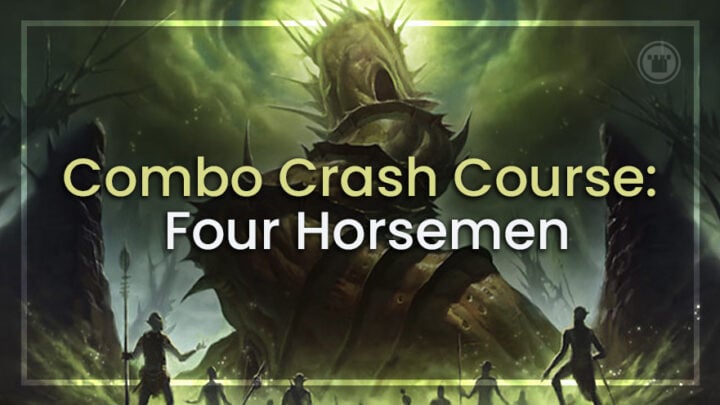For many players, combo decks feel like you’re showing someone a Magic trick. The sheer depth of Magic’s card pool creates the potential for you to invent genuinely new strategies, and then wield those creations to astonish and destroy your foes! That depth of expression is a huge part of the game’s appeal, and it’s why combo decks are considered a valuable part of every format’s metagame.
In particular, non-deterministic combos like Storm, Elves or Doomsday have enduring popularity because they give players the chance to make different game-clinching plays every time – each match a unique showcase for your hard-won skill and creativity.
But there is also at least one instance where a non-deterministic combo created a sort of glitch in Magic’s game engine: a glitch which not only has never been repaired, but proved so intractable and annoying that it became policy to just disqualify anyone who tried to replicate it during tournament play.
This is not going to be your usual Combo Crash Course. Today, by special request, we’re gonna talk about the Magic urban myth that is the Four Horsemen combo.
WHAT IS FOUR HORSEMEN
Besides its unique struggles with legality (which we’ll cover in a minute), part of this deck’s mystique comes from its complicated combo, which has a lot of steps and moving parts. Most of the time needing more than two or three combo pieces is a death knell for competitive viability. But by building around a self-mill engine and multiple means of recursion, Four Horsemen pilots can use their initial pieces to quickly flip their deck into the yard and assemble the rest of the combo from there.
Mesmeric Orb plus Basalt Monolith is the classic starting point for the engine. The Monolith’s paired activations effectively give you unlimited “untap a permanent” triggers, which lets you mill yourself at will with the Orb from as early as turn three. It’s not the fastest possible self-decking combo in Magic, but it does let you mill yourself in single-card increments – which turns out to be quite important.
Narcomoeba plus Dread Return is the least inventive stage of the combo, but I suppose there’s only so many ways to immediately convert self-mill into winning actions. With at least three Narcomoeba in the deck (the fourth is usually worth it as a spare), we can simply mill our deck, put the Illusions into play, flashback the Dread Return and reanimate our primary threat. Some people will claim these Narcomoebas are the deck’s titular Horsemen, but I don’t know if I agree. After all, there’s four other cards which have a lot more to do with the deck’s place in Magic history.
Self-mill decks today usually default to Thassa’s Oracle as a wincon, but the players who built Four Horsemen over a decade ago had to be a bit more creative. They would sacrifice the Narcomoebas to bring back Sharuum the Hegemon, all as a roundabout way to finally reanimate Blasting Station.
Like Dread Return, Blasting Station has excellent synergy with Narcomoeba, effectively converting each free jellyfish into a point of direct damage on our opponent. This doesn’t sound so exciting with just four Narcomoeba in the deck (and only one left assuming we’ve just Dread Return’d), but that’s where the final combo piece comes in.
Emrakul, the Aeons Torn is here almost exclusively for her put-into-graveyard trigger, which allows us to shuffle our milled cards (plus any sacrificed Narcomoeba) back into our deck for another go through. Now we can actually mill ourselves ad infinitum, netting four Blasting Station activations per loop, and eventually zapping our opponent to death before they get a chance to untap. Remember, this could all happen turn three of your original Basalt Monolith cast!
CATCH FORTY FOUR
If you’re not already familiar with the story of Four Horsemen, you might be coming out of that breakdown a little bemused. OK, the combo line is a little overwrought, but all the individual steps involved seem like normal, legal Magic interactions. The decklist isn’t hiding any banned cards, or trying to smuggle in a surreptitious fifth Narcomoeba.
Indeed, it has never been illegal to register a Four Horsemen deck in tournaments, nor do I know of one failing a pre-match deck check. The weirdest part of the story is this combo only becomes illegal if you try and win with it in a match – at which point most judges will step in and disqualify you.
So, how does this glitch in the Magic matrix actually happen?
Assume we’re up to the second phase of the gameplan: after we assemble the Orb-Monolith mill engine, but before we have Blasting Station in play to actually kill our opponent. The goal in this transitional moment of the combo is simply to mill the other pieces out of your deck so we can use them. There’s usually only one copy each of Sharuum, Dread Return and Blasting Station, so we’ll probably need to mill through the bulk of the deck to find all three.
Our problem is the fourth singleton combo piece – Emrakul. Since her all-important reshuffling trigger is not optional, flipping her over resets immediately resets our graveyard and obliges us to restart our self-milling from scratch!
Still, we are working with infinite self-mill activations here. The likelihood of any one deck reshuffle placing Emrakul lower down than all three of the other “horsemen” isn’t especially high, but it’s a lot higher than zero! We’ll just explain the Orb-Monolith interaction, demonstrate that we have Emrakul to prevent us from actually decking out, and then – assuming no relevant interaction from the opponent – declare that we carry on this reshuffle loop until our horsemen show up in the right order to win. Problem solved!
LEGAL LOOP-HOLES
Alas, we have only just begun to sink into the quicksand that is Magic rules technicalities. There’s a reason you have to pass an exam to judge events (which I have not actually done; apologies to any actual judges in the audience if I goof up this explanation…)
Demonstrating a repeatable loop of actions as a way to skip over actually performing all of them hundreds of times is an extremely common and foundational part of the game, especially in tournament play. You couldn’t really have most “infinites” without it, and anyone who’s tried to play certain action-intensive combos on Magic Online or Arena will understand how arduous it can be to have to go through those motions under time pressure.
But because loops and shortcuts are part of Magic’s official rules, they have specific official definitions – and requirements. You can only declare a loop of actions if each iteration of the loop advances the game state – if there’s a quantifiable difference between the “before” and “after” snapshots each time you go through it.
Tragically for the Four Horsemen combo, our loop does not add mana to our pool, draw cards, make creature tokens, deal damage, accrue energy counters, venture into the dungeon, or do anything else that would count as advancement under official rules. Once we get all the Narcomoebas out of our deck in the first few iterations, the only detail of the gamestate that changes from one post-reshuffle snapshot to the next one is the order of those cards in our library… which is unknown information.
In the context of a tournament match, it’s impossible to know whether a given shuffle is the “right” one until we actually flip the cards over. We might argue that we have infinite reshuffle attempts to get it right, but Magic technically doesn’t allow infinites. Under tournament rules, you have to actually pick a real number for how many loops you want to skip through, even if it’s arbitrarily high (e.g. “I attempt to equip Shuko to Cephalid Illusionist ten trillion times”).
Read our Crash-Course on this much more successful self-mill combo here!
Common sense says that it would take somewhat fewer than ten trillion reshuffles to make our combo work. But mathematically speaking, even a huge number of perfectly randomized shuffles could end up putting all your cards in the exact same order, every time, until the heat death of the universe.
Since we can neither prove that one face-down deck of fresh-shuffled cards is different from another, nor give a specific number of iterations which will 100% guarantee we reach the desired end state, the Four Horsemen infinite reshuffle process does not match the official definition of a loop under Magic rules, and there is no legal grounds for shortcutting it.
THE LEGEND RIDES ON
As disheartening and arbitrary as that rules situation may be, it still doesn’t seem to fully explain why you can get disqualified for trying to play Four Horsemen at tournaments. If you’re not allowed to skip ahead past all the shuffling, fine – just go through the whole combo in real time.
Remember, we’re mainly talking about paper Constructed events: we get roughly an hour with each opponent to play our best-of-three set. If you consider how soon in the game we can get our Orb-plus-Monolith set up, we could easily have another thirty minutes left to reshuffle and flip over our cards! It might not be the most exciting game for our opponent, but hey – they can choose to sign the match slip and concede at any point.
Except… any time you start to go through that reshuffling process, you are risking a warning or potential disqualification as soon as a judge wanders through your area. Reshuffling your deck over and over without also advancing the board state is official grounds for Slow Play penalties, for the exact same reasons that make it invalid as a loop. It doesn’t really matter how long you were actually going to take to do the combo, or even how efficiently you execute it. If you are repeating actions without advancing the gamestate, it’s over.
While there has never been an official ban or notice against this deck, these negative rulings from floor judges led to a community understanding that Four Horsemen was “soft banned”, making serious players even less likely to consider it valid in any metagame.
But the combo lives on – if not as a prominent or dominant archetype, then as a fascinating tale of one stubborn pothole in Magic’s normally robust ruleset. For game design nerds like myself, Four Horsemen is an amazing example of how Magic’s immense complexity can support expression beyond what its creators can imagine – or even rule on satisfactorily.
Jokey indignation aside, I think it’s actually far more worthwhile for the game to have Four Horsemen exist as some kind of legendary outlaw combo than to see it legalized and fade into irrelevance as another C-tier deck.
The Horsemen are dead – long live the Horsemen!

Tom’s fate was sealed in 7th grade when his friend lent him a pile of commons to play Magic. He quickly picked up Boros and Orzhov decks in Ravnica block and has remained a staunch white magician ever since. A fan of all Constructed formats, he enjoys studying the history of the tournament meta. He specializes in midrange decks, especially Death & Taxes and Martyr Proc. One day, he swears he will win an MCQ with Evershrike. Ask him how at @AWanderingBard, or watch him stream Magic at twitch.tv/TheWanderingBard.










